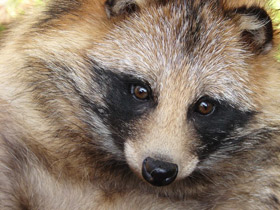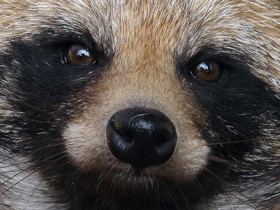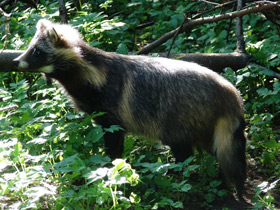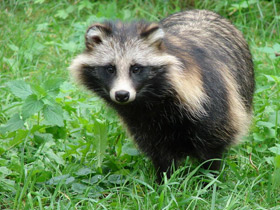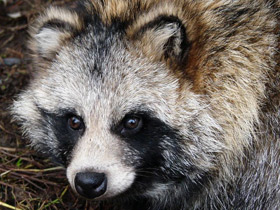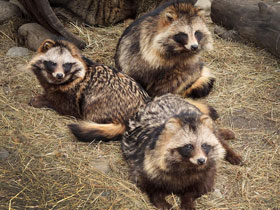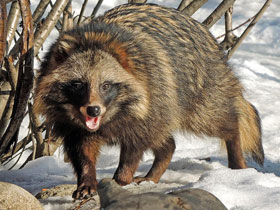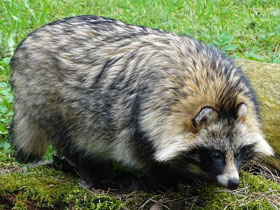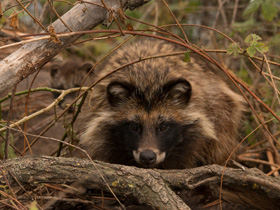The common raccoon dog, the Chinese or Asian raccoon dog (Nyctereutes procyonoides)
The common raccoon dog (Nyctereutes procyonoides), also called the Chinese or Asian raccoon dog to distinguish it from the Japanese raccoon dog, is a small, heavy-set, fox-like canid native to East Asia. Named for its raccoon-like face markings, it is most closely related to foxes. Common raccoon dogs feed on many animals and plant matter, and are unusual among canids (dogs, foxes, and other members of the family Canidae) in that they hibernate during cold winters and can climb trees. They are widespread in their native range, and are invasive in Europe where they were introduced for the fur trade. The similar Japanese raccoon dog (Nyctereutes viverrinus, the tanuki), native to Japan, is the only other living member of the genus Nyctereutes. Other names for the common raccoon dog include mangut (its Evenki name), and neoguri (its Korean name).
The common raccoon dog is named for the resemblance of its masked face to that of the North American common raccoon (Procyon lotor). The closest relatives of the common raccoon dogs are the true foxes, not the raccoon, which is one of the musteloids, and not closely related. Among the Canidae, the common raccoon dog shares the habit of regularly climbing trees only with the North American gray fox, which is neither a true fox nor a close relative of the common raccoon dog.
Due to the fur trade, the common raccoon dog has been widely introduced in Europe, where it has been treated as a potentially hazardous invasive species. In Scandinavia, it is called "marten-dog" (Swedish: mårdhund, Norwegian and Danish: mårhund). In Europe, since 2019, the common raccoon dog has been included on the list of Invasive Alien Species of Union concern (the Union list). This implies that this species cannot be imported, bred, transported, commercialized, or intentionally released into the environment in the whole of the European Union.
Appearance
Nyctereutes procyonoides is a species of carnivorous mammal in the family Canidae.
Nyctereutes procyonoides is an unusual member of the Canidae family and, in fact, somewhat resembles Procyon lotor in the colour of its snout, which also bears a distinctive dark mask-like pattern. It is medium-sized, with a body length of 65-80 cm and a tail of 15-25 cm and a weight of 4-10 kg.
The body of Nyctereutes procyonoides is stout and long, and the legs are short. Its coat is dark brown and lighter underneath; it is long (up to 12 cm) and dense. It is somewhat rough to the touch, but its undercoat is very soft and fluffy. Its long coat covers the whole body and even the tail, giving it a shaggy appearance. It has shorter but no less dense hair on the legs, a dark stripe along the spine and ash grey "sideburns" on the cheeks, and a short fluffy tail without transverse bands. The head of Nyctereutes procyonoides is medium-sized with a narrow muzzle; the ears are small, erect and always black. The colouration of Nyctereutes procyonoides is mostly striped, similar to that of Procyon lotor. The beast becomes slightly lighter in winter, but the black "muzzle-mask" on its head is present at all times of the year.
Habitat area
The natural habitat of Nyctereutes procyonoides is the forests and mountainous areas of northeastern Indochina, China, Japan and the Korean peninsula. In Russia, it was originally found only in Ussuriiskii Krai and the southern part of the Amur region. Between 1927 and 1957, about 10,000 Nyctereutes procyonoides were introduced and released in 76 regions of the former USSR to enrich hunting grounds. They did not take root in the Asian part of the country, but in the European part of the country they multiplied rapidly and began to spread further, even into Western Europe, entering Finland, Estonia, Sweden, Poland, Romania, the Czech Republic, Germany and France. The preferred habitats of Nyctereutes procyonoides are wet meadows with marshy lowlands, river floodplains and riparian forests with dense undergrowth. It does not need much shelter; its refuges can be badger and fox burrows (often inhabited), less often self-excavated, as well as niches between tree roots, rock crevices, etc. Shelters are usually located near roads and villages. Sometimes Nyctereutes procyonoides is content with open roosts.
Nutrition and lifestyle
Nyctereutes procyonoides is active mainly at dusk and at night. Nyctereutes procyonoides is a predator, but in the spring and autumn seasons it can feed on vegetables and fruits, various roots and grasses. In terms of foraging, it is a typical forager, exploring all sorts of hidden places in search of food. It often wanders in shallow waters near the shores of forest ponds or along sea shores.
During a hunt in the warm season it can travel 7-10 km, but due to its short legs it gets bogged down in the snow a lot. Nyctereutes procyonoides is the only one of the canid family that in case of danger, if it can, prefers not to fight but to hide, playing dead, which often saves it.
In summer it feeds on rodents, birds and their eggs, frogs and beetles, and in autumn on oats, berries and fallen fruit; it does not skimp on carrion, dead fish and scraps of food. In winter Nyctereutes procyonoides gains up to 2 kg or more and hibernates. It is the only member of the canine family that hibernates in winter. Nyctereutes procyonoides does not have a true hibernation, but its metabolic rate is reduced by about 25%. Hibernation lasts from December-January to February-March; it is interrupted during thaws. During warm winters, Nyctereutes procyonoides is usually awake, sheltering only on days of heavy frosts and blizzards.
Reproduction
Nyctereutes procyonoides live in pairs. Pairs are formed from October-November onwards, so that oestrus in February-April is rarely accompanied by fighting between males. Pregnancy lasts about 60 days. A litter contains 6 to 8 (sometimes up to 14 or 16) pups. The fertility of the females depends to a large extent on their fatness and climatic conditions. Both parents participate in the rearing of the pups. The pups grow rapidly and reach adult size in late autumn. Puberty occurs at 8-10 months of age. The lifespan of Nyctereutes procyonoides is 3-4 years in the wild and up to 11 years in captivity.
Invasive species
Due to its colonising potential and constituting a serious threat to native species, habitats or ecosystems, this species has been included in the Spanish Catalogue of Invasive Alien Species, regulated by Royal Decree 630/2013, of 2 August, and its introduction into the natural environment, possession, transport, traffic and trade are prohibited in Spain.
Subspecies:
Five subspecies of Nyctereutes procyonoides are recognised:
- Nyctereutes procyonoides procyonoides procyonoides;
- Nyctereutes procyonoides koreensis;
- Nyctereutes procyonoides orestes;
- Nyctereutes procyonoides ussuriensis;
- Nyctereutes procyonoides viverrinus.

















